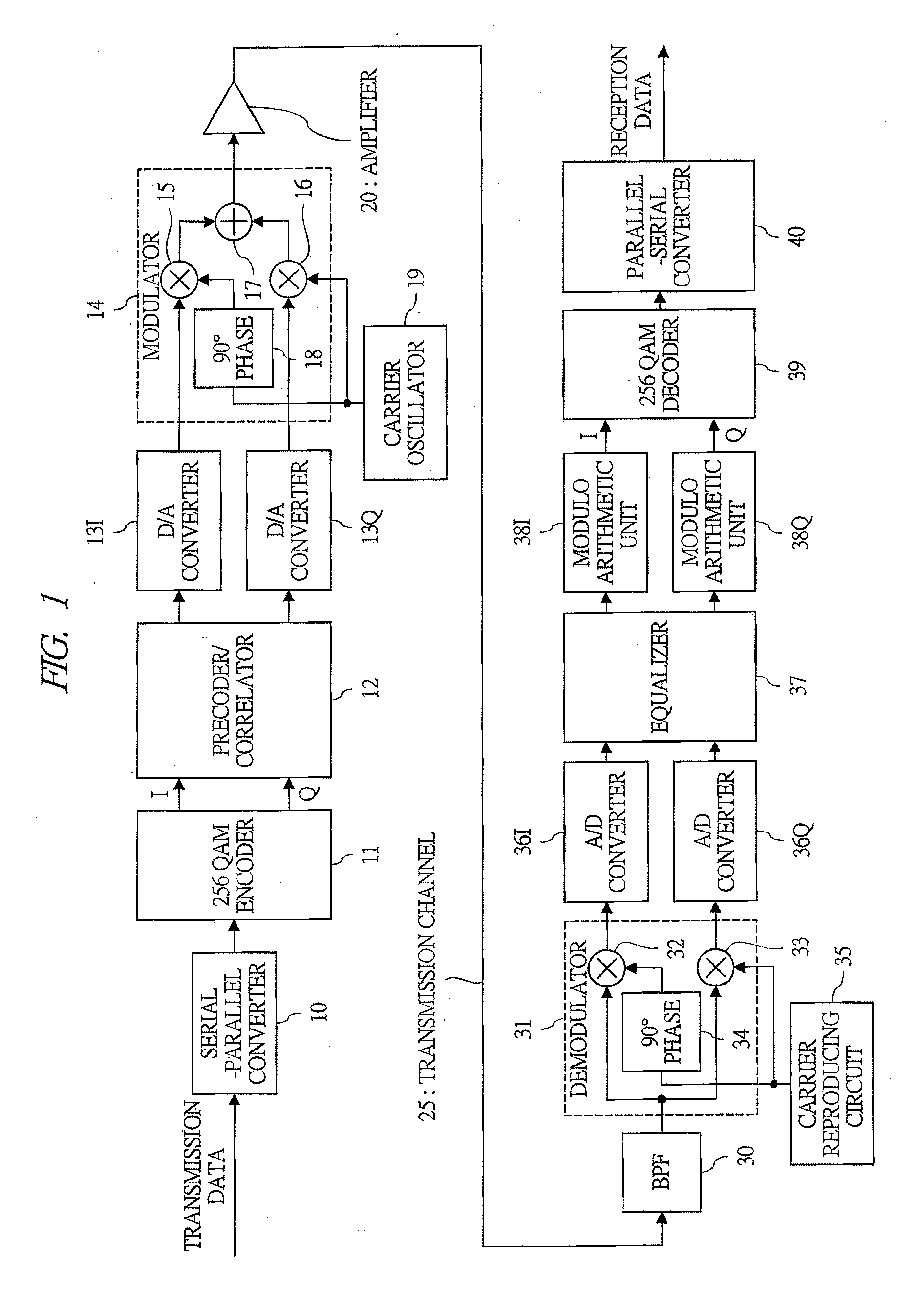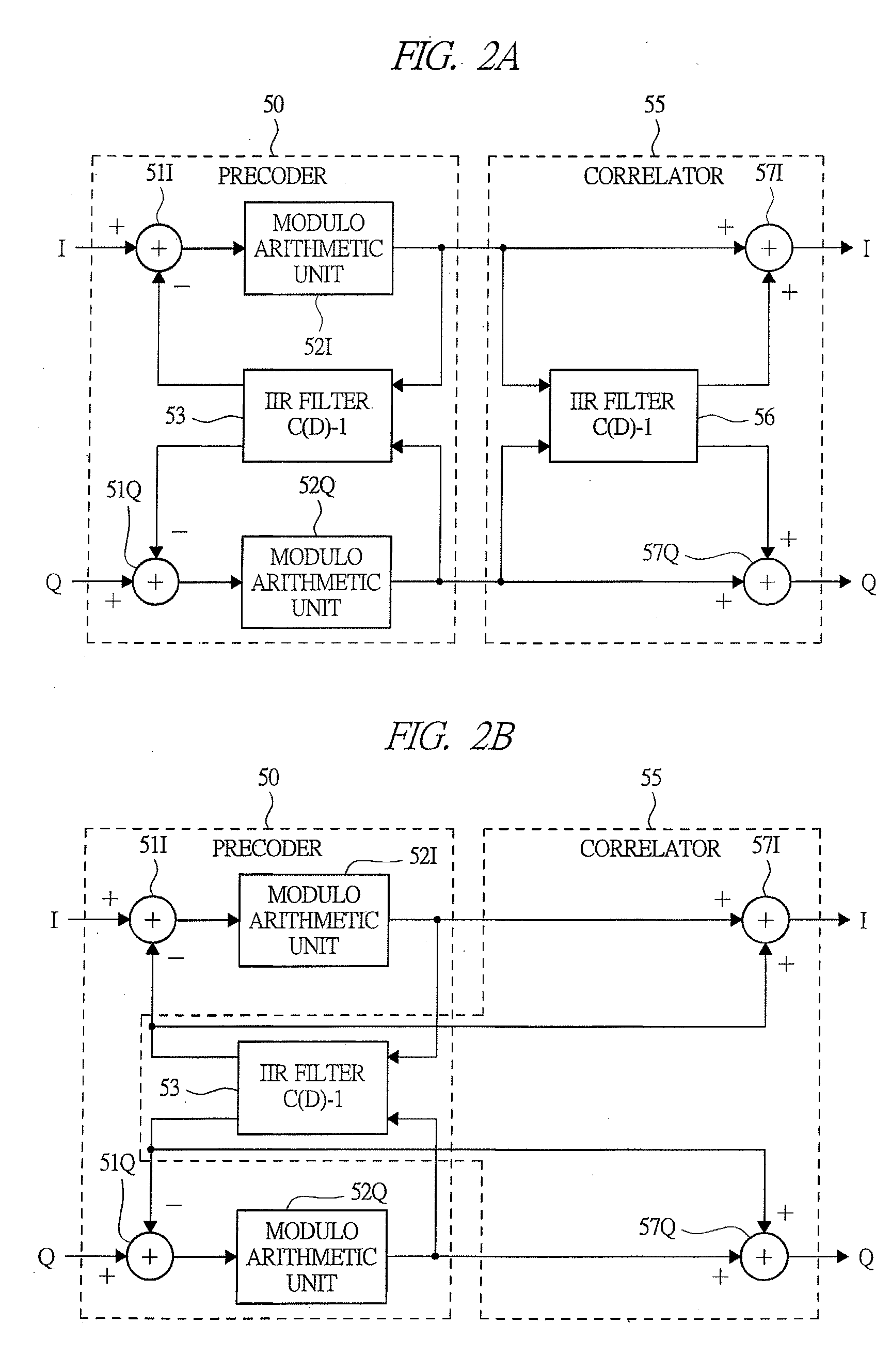Signal transmission apparatus and signal transmission method
a transmission apparatus and signal technology, applied in the direction of transmission/receiving by adding signal to wave, power distribution line transmission, modulation, etc., can solve the problems of reducing transmission efficiency, reducing transmission efficiency, and diverging equalizers, so as to improve transmission efficiency and reduce delay , the effect of simplifying circuit configuration and signal process
- Summary
- Abstract
- Description
- Claims
- Application Information
AI Technical Summary
Benefits of technology
Problems solved by technology
Method used
Image
Examples
first embodiment
[0062]the present invention will be described below. FIG. 1 is a block diagram showing the configuration of the embodiment of the signal transmission apparatus of the present invention. An upper part of FIG. 1 corresponds to a sending unit and a lower part thereof corresponds to a receiving unit. Digital transmission data is converted to, for example, an 8-bit parallel signal by a serial-parallel converter 10. The 8-bit parallel signal is inputted to a 256 QAM encoder 11, and the 256 QAM encoder 11 converts the signal to a 256 QAM signal having 16×16 lattice by a known method and outputs signals I and Q.
[0063]A precoder / correlator 12, details of which will be described later, performs the processes according to the present invention to the signals I and Q so as to obtain a desired notch characteristic. The function and process of the sending unit except the precoder / correlator 12 are the same as those of a conventional QAM sending unit. Note that the processes before the precoder / co...
third embodiment
[0109]FIG. 14 is a block diagram showing the configuration of the precoder / correlator 180 of the modified embodiment. The block of the precoder / correlator 180 of the modified embodiment is the same as that of the third embodiment shown in FIG. 9B. However, the transfer function set in an IIR filter of a precoder 190 is a product between transfer functions CT(D) and CF(D) corresponding to variable notch characteristic and fixed notch characteristic which suppress the transmission signal and a transfer function CR(D) corresponding to the notch characteristic which suppresses the external noise signal in the receiving unit.
[0110]More specifically, the signal to be inputted to an adder 191 is [CT(D)*CF(D)*CR(D)−1]. On the other hand, the signal to be inputted to an adder 196 of a correlator 195 is [CT(D)*CF(D)−1]. Therefore, the transmission signal has the notch characteristic corresponding to the transfer function [CT(D)*CF(D)].
[0111]Note that, in the present invention, CT(D) is a tran...
fourth embodiment
[0126]In the fourth embodiment, with using the data transmission periods (A) to (C) to each MODEM in FIG. 15, the notch frequency is measured cyclically or when the transmission quality is deteriorated. FIG. 11 is a flow chart showing the contents of the null point search process 2 of the present invention. In this process, the notch frequency is moved at a slow speed which the equalizer on the receiving side can follow in the master MODEM, and a time position in which the transmission quality is optimum on the receiving side is detected, and then, this time position is converted to the notch frequency.
[0127]In S30, the master MODEM determines whether or not a predetermined time elapses after a previous process, and when a determination result is negative, the procedure proceeds to S30. On the other hand, when it is positive, the procedure proceeds to S31. In the meantime, whether or not the transmission quality is deteriorated below a predetermined value may be determined instead. ...
PUM
 Login to View More
Login to View More Abstract
Description
Claims
Application Information
 Login to View More
Login to View More - R&D
- Intellectual Property
- Life Sciences
- Materials
- Tech Scout
- Unparalleled Data Quality
- Higher Quality Content
- 60% Fewer Hallucinations
Browse by: Latest US Patents, China's latest patents, Technical Efficacy Thesaurus, Application Domain, Technology Topic, Popular Technical Reports.
© 2025 PatSnap. All rights reserved.Legal|Privacy policy|Modern Slavery Act Transparency Statement|Sitemap|About US| Contact US: help@patsnap.com



